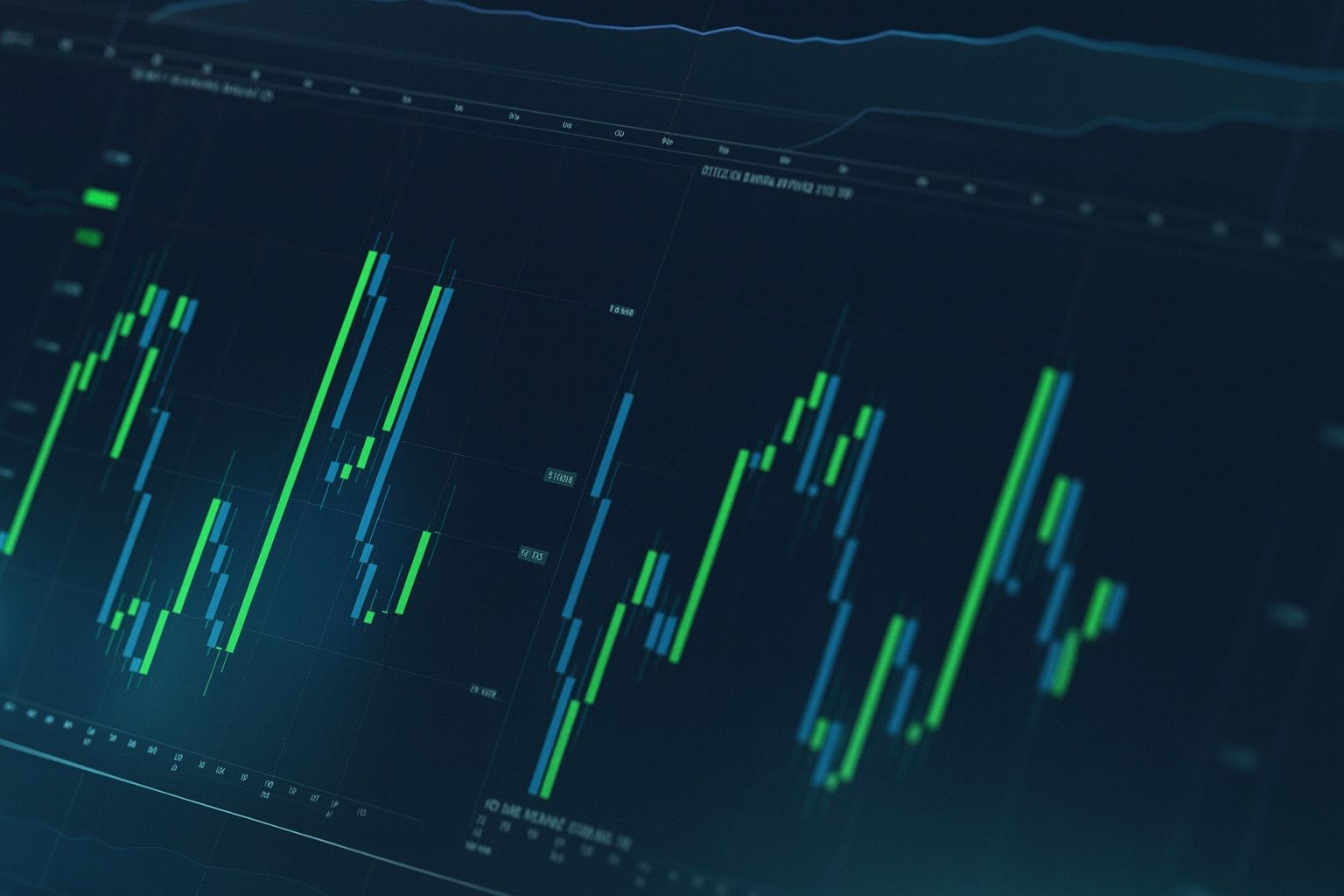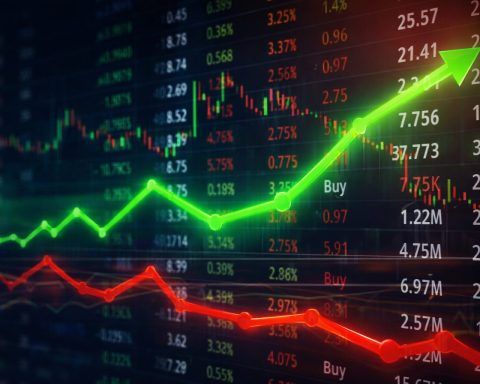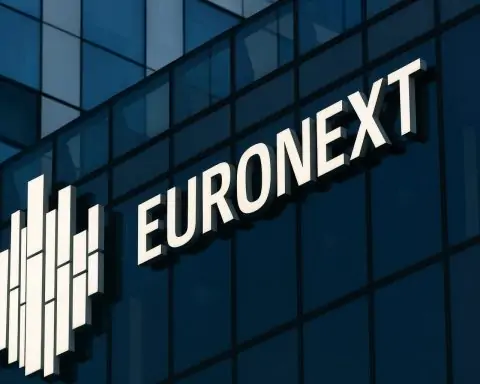- Regional Bank Rout: U.S. regional bank stocks plunged after Zions Bancorporation revealed a surprise $50 million loan loss tied to alleged fraud, sparking broader fears about credit quality [1]. Zions’ stock (NASDAQ: ZION) tumbled ~13% on Oct. 16, 2025 into the high-$40s per share [2], its biggest one-day drop in six months [3]. Western Alliance Bancorp (NYSE: WAL) fell about 11% in sympathy [4] after disclosing it had lent to the same borrowers and had already filed a fraud lawsuit in August [5].
- Market Selloff Spreads: The shockwaves wiped out over $100 billion in U.S. bank market value as investors fled the sector [6]. The KBW Regional Banking Index sank ~5–6% [7], dragging down major indexes. The S&P 500 slid nearly 1% and the Dow Jones Industrial Average erased an early rally to close almost 400 points lower on Thursday [8] [9]. Even banks with no direct connection sold off, and Jefferies Financial Group (NYSE: JEF) – which has exposure to a recent auto-industry bankruptcy – dropped ~10% on credit contagion fears [10].
- Global Jitters & Gold Record: Signs of U.S. credit stress rattled overseas markets. Japan’s Nikkei fell 1.6% and Hong Kong’s Hang Seng 2% on Friday, followed by Europe’s bank stocks sliding ~2.7% [11]. London’s FTSE 100 shed 1.5% at the open [12]. Safe havens surged: Gold prices hit an all-time high above $4,378 per ounce [13] (up ~8% this week) as jittery investors sought refuge, marking gold’s largest weekly gain since 2008. U.S. Treasury yields plunged – the 10-year yield sank to 3.97%, a 2025 low [14], and the 2-year yield hit a three-year low near 3.38% amid expectations the Federal Reserve will cut rates to stabilize the economy [15].
- “Cockroach” Credit Worries: The back-to-back fraud revelations have stoked debate over whether these are isolated incidents or a warning of broader issues [16] [17]. “When you see one cockroach, there are probably more,” JPMorgan CEO Jamie Dimon warned this week, after his bank took a $170 million loss on a different bad loan [18] [19]. Analysts note that a string of recent “one-off” loan blowups – from subprime auto lender Tricolor’s fraud-tainted bankruptcy in September to auto-parts maker First Brands’ collapse owing $10+ billion – has investors on edge [20] [21]. “It shows you can’t take credit quality for granted, and poor credit at one bank can drag down the group fast,” said Stephen Biggar of Argus Research [22]. Faced with these surprises, “investors are selling first and asking questions later,” JPMorgan analysts wrote, questioning why so many credit problems are surfacing in quick succession [23] [24].
- Outlook – Fear vs. Fundamentals: Bank executives insist these issues are manageable and specific. Zions’ management called its $50 million hit an “isolated” case and has hired outside investigators to ensure it’s truly a one-off event [25]. “Zions faces the challenge of showing this is a one-off and not a broader weakness,” said Zacks analyst Brian Mulberry [26] ahead of the bank’s Oct. 20 earnings report. Western Alliance reports Oct. 21, and despite recent volatility (WAL ~$78 on Oct. 16 [27]), Wall Street remains optimistic – the stock’s consensus rating is “Strong Buy” with a ~$103 average target (≈30% above current levels) [28]. Similarly, analysts still rate ZION a Hold but with a ~$61 target [29], implying significant upside if fears subside. Big banks also seem unworried: aside from JPMorgan’s precautionary boost, the top five U.S. banks collectively set aside the least loan-loss reserves in two years last quarter, signaling they aren’t bracing for a credit apocalypse [30]. While some strategists warn the market could see another 5–10% pullback as it digests these credit scares [31], others maintain that “the bull market remains intact” and view pullbacks as buying opportunities [32]. In short, unless deeper cracks spread, many believe the 2025 economic expansion – and stock rally – “may bend but not break” despite the current jitters [33].
Fraud Shock at Zions and Western Alliance Triggers Selloff
Zions Bancorp (a Utah-based regional lender) stunned investors mid-week by disclosing a major credit mishap involving apparent fraud. In an Oct. 15 SEC filing, Zions said it discovered “misrepresentations and contractual defaults” in two large commercial loans totaling about $60 million at its California Bank & Trust unit [34] [35]. The bank moved swiftly: it accelerated the loans to default, filed a lawsuit against the guarantors, and wrote off $50 million, effectively recognizing the entire exposure as a loss while it tries to recover funds [36]. This surprise hit – unusual for a bank that typically makes much smaller business loans – immediately raised questions about Zions’ underwriting and risk controls [37]. “The optics of a large C&I loan to a fraudulent borrower from a bank that specializes in small C&I loans is not great,” noted Raymond James analysts, who said the news cast doubt on Zions’ risk management [38].
Investors reacted swiftly and harshly. ZION shares plunged about 12–13% on Oct. 16, wiping out roughly $600–700 million in market value as the stock fell into the upper-$40s – its lowest in months [39] [40]. The one-day drop erased a recent rebound (ZION was up ~3.5% just two days prior on strong big-bank earnings) and left the stock down ~10% year-to-date and more than 20% below its 52-week high [41]. The news immediately ignited fears of what other problems might lurk on regional bank balance sheets in an era of high interest rates and slowing growth. “Hidden credit stress” is how Reuters described the market’s mood [42] – essentially, investors wondering if this was the first roach scurrying out of the pantry.
The contagion spread quickly. Western Alliance Bancorp, a Phoenix-based peer, saw its stock nosedive ~11% the same day [43]. Western Alliance wasn’t directly involved in Zions’ loans, but it revealed it had a revolving credit line to a related borrower and had sued that borrower for fraud back in August (after the borrower allegedly provided fake collateral) [44] [45]. Western Alliance’s management insisted its exposure was secured and already identified – they even noted that their total “criticized” (weak) assets had declined since June [46]. That assurance helped WAL stock pare intraday losses on Oct. 16 [47], but the episode still shook confidence in the sector. “The fact another respected regional bank was even tangentially caught up in a fraud scenario shook confidence,” TS2.tech observed [48].
Beyond those two, sell-first-ask-questions-later thinking took hold. Any bank seen as exposed to risky loans or opaque borrowers got hit. The S&P Regional Bank ETF (KRX) plunged about 5.8% [49], reflecting a sector-wide rout. Even larger financial names weren’t spared: Jefferies Financial Group, an investment bank that had disclosed hundreds of millions in exposure to bankrupt First Brands Group, tumbled ~9–10% as the Zions news stoked “what’s next?” anxiety [50] [51]. “It shows you can’t take credit quality for granted, and poor performing credit at one bank can drag down the group quite fast,” said Stephen Biggar, a banking analyst at Argus Research [52]. That sentiment was echoed on trading floors, as evidenced by the broad sell-off in bank stocks despite a generally strong earnings season for major banks just days earlier.
Major stock indexes recoiled. In New York, the bank turmoil halted what had been a tentative rebound early in the day. By the close on Thursday (Oct. 16), the benchmark S&P 500 index was down almost 1% [53] and the Dow Jones Industrial Average shed about 300–400 points (around 1%) [54]. Notably, stocks had opened higher that morning on solid corporate earnings, only to reverse course midday as the bank fears gained traction. “Major indexes turned lower after being up for much of the session, with the Dow losing close to 400 points late in the day,” as one market report described [55]. The tech-heavy Nasdaq also slipped ~1%+. In short, a regional bank issue managed to flip market sentiment, illustrating how sensitive investors remain to any hint of financial stress in the system.
Credit Fears Go Global as Safe Havens Surge
By Friday Oct. 17, the jitters had spread globally. Asian markets fell overnight, with Japan’s Nikkei 225 index down about 1.6% and Hong Kong’s Hang Seng off ~2% [56]. In Europe, the opening bell brought an extension of the sell-off: London’s FTSE 100 slid ~1.5% early on, Germany’s DAX dropped ~2%, and France’s CAC 40 about 1.5% [57]. Europe’s bank-heavy STOXX 600 index fell 1.8%, while the Euro Stoxx Banks index tumbled ~2.7% [58]. Big European lenders like Deutsche Bank and Barclays saw their shares sink 5%+ in sympathy [59]. “Signs of credit stress at U.S. regional lenders unnerved investors” worldwide, Reuters noted, pulling down equities from Madrid to Mumbai [60].
Crucially, safe-haven assets caught a strong bid amid the turmoil. Gold prices rocketed to record highs, a classic fear gauge. The yellow metal surged above $4,378 per ounce – a new all-time high – on Friday [61]. That put gold up roughly 7–8% for the week, its best weekly jump since the 2008 financial crisis [62]. “It wouldn’t surprise me if gold hits $5,000 before it stops for air… Equally, it could fall 20% next month,” quipped Eren Osman of Arbuthnot Latham, reflecting the frenzied rush into precious metals [63]. The soaring gold price underscores just how anxious investors have become: they are willing to pay record prices for an asset seen as a hedge against financial calamity.
U.S. Treasury bonds also rallied hard as investors sought safety. Yields, which move opposite to prices, plunged to multi-year lows. The 10-year Treasury yield fell to ~3.97% [64] – its first time below 4% this year and the lowest level in 2025 [65]. The 2-year yield, even more sensitive to interest rate expectations, dived to around 3.38%, a level not seen in three years [66]. These sharp moves imply that markets are increasingly betting on Federal Reserve rate cuts in the near future. In fact, futures traders are now pricing in at least two quarter-point Fed cuts by year-end [67], as the central bank may need to cushion the economy. “Safe-haven Treasuries rallied further… investors priced in at least two more rate cuts from the Fed this year,” Reuters reported [68] [69].
Other classic fear signals flared as well. The Japanese yen and Swiss franc – currencies that tend to strengthen in times of stress – each rose ~1% on the week against the U.S. dollar [70] [71]. The dollar index fell ~0.6%, showing a waning appetite for risk assets [72]. Oil prices, conversely, slumped to five-month lows amid broader growth worries and hints of a diplomatic breakthrough in geopolitical conflicts (U.S. President Trump signaled a possible summit with Russia’s Putin to discuss ending the Ukraine war) [73] [74].
It’s worth noting that these banking woes hit a market already grappling with other clouds. An escalating U.S.–China trade spat has been simmering in October, contributing to volatility. Just a week earlier, an abrupt “tariff tantrum” shook markets when former President Trump threatened 100% tariffs on Chinese goods, sending the S&P 500 down 2.7% in one day [75]. Tensions remained high this week: Beijing accused Washington of stoking panic over new Chinese export curbs on rare earth minerals [76], while U.S. officials urged China to reverse those controls. This backdrop of trade uncertainty and even a partial U.S. government shutdown (now over two weeks old, delaying economic data releases) has created a “wall of worry” for investors [77] [78]. The regional bank scare was thus pouring fuel on an already flickering fire. As Richard Hunter of Interactive Investor observed, “There are increasing signs of storm clouds gathering over markets, with little relief from the building wall of worry” – from stretched tech stock valuations, to the unresolved shutdown, to deteriorating U.S.–China relations, and now “bad loans at US regional banks” joining the list [79] [80]. Little surprise, then, that global investors are shunning risk and flocking to safe havens until some of these threats diminish.
Are These “One-Off” Blunders or the Tip of an Iceberg?
A central question now looms: Is the regional banking drama an idiosyncratic blip or a sign of systemic cracks? Thus far, bank executives and many analysts maintain that the Zions and Western Alliance incidents are specific and contained. Zions’ CEO Harris Simmons characterized the loans-gone-bad as “an isolated situation” in the 8-K disclosure, stressing that an outside law firm is conducting an independent review to ensure no broader issues [81]. Western Alliance’s management likewise emphasized that their fraudulent borrower issue was already being dealt with and that overall credit quality has not deteriorated (their problem loans actually decreased quarter-over-quarter) [82]. In other words, these banks argue, they stumbled on a rogue bad actor, not a widespread credit meltdown.
Skeptical investors, however, “will require proof”. “Zions faces the challenge of showing this is a one-off event and not indicative of broader credit control weakness,” said Brian Mulberry, portfolio manager at Zacks Investment Management [83]. That proof will need to come through in coming quarters’ results – starting with Zions’ Q3 earnings call on Oct. 20. Analysts will be laser-focused on whether any other loan issues emerge and on what steps management is taking to tighten lending standards or oversight. As Truist Securities noted, banks have seen enough surprise credit events lately that investors have adopted a “sell first, ask questions later” mentality [84]. Every new “cockroach” fuels that fear that more may be lurking unseen.
Historical parallels are hard to ignore. The current situation is distinct from the 2023 banking mini-crisis (when Silicon Valley Bank’s bond losses sparked a depositor panic), but it rhymes in one aspect: rising interest rates are exposing weaknesses. Back in 2023, it was poor interest-rate risk management; in 2025, it appears to be pockets of credit risk coming home to roost after a period of easy money. Jamie Dimon’s warning about “more cockroaches” was specifically about the boom in private credit – lightly regulated lending often done by non-banks – which has surged in recent years [85] [86]. The collapse of First Brands Group in September shone a light on this: the auto-parts firm had amassed huge off-balance-sheet debts via complex financing deals, catching many lenders off guard [87] [88]. “It shows cracks in the system that allows for shadow banking,” noted one market expert of the First Brands fiasco [89]. Now Zions and Western Alliance reveal that even traditional banks can get entangled with opaque investment funds and “mystery” loans (in this case tied to distressed commercial real estate). The common thread is lack of transparency – lenders and investors not fully understanding the risks until it’s too late.
Wall Street analysts are divided on the implications. JPMorgan’s research team acknowledged this week that the rash of credit surprises is unsettling, writing “this is an industry where investors… tend to sell first and ask questions later” when credit concerns escalate [90] [91]. They also pointedly asked “why all of these credit ‘one-offs’ are occurring in a short period of time” [92] – hinting at the idea that something larger may be afoot (be it the economic cycle turning, or simply that rising rates are flushing out bad deals made during the cheap-money era). Deutsche Bank’s Jim Reid observed that while the Zions/WAL losses are relatively small, “the event drew inevitable comparisons to the regional bank stress [after] the collapse of SVB in 2023,” coming as it does after a “lengthy period of elevated rates and an expansion in private credit” that could be sowing landmines [93]. In other words, after a decade of “freewheeling capital” (as the Straits Times put it) the bill may be coming due [94].
On the other hand, some see these incidents as isolated and fixable. For one, the dollar amounts are modest in the scheme of things – tens of millions lost, not billions [95]. Big banks can absorb hits of that size “fairly easily,” Dimon noted [96]. It’s the smaller regional lenders that feel more impact, but even for Zions, a $50M charge-off while painful (likely cutting this quarter’s profit roughly in half) is survivable given the bank’s capital buffers and profitability. “These appear to be idiosyncratic, borrower-specific failures,” said one analyst, pointing out that Zions’ loans went to an independent investment fund – an unusual outlier for them [97] [98]. Several bank analysts (Piper Sandler, Raymond James, Stephens, etc.) have reiterated neutral or hold ratings on ZION stock after the drop, essentially taking a “wait and see” approach [99] [100]. Notably, insiders and industry executives aren’t hitting the panic button: large banks in Q3 did not significantly boost their loan-loss reserves (in fact, Morgan Stanley added zero to reserves) [101], implying they aren’t observing a broad deterioration in loan performance. This suggests that, so far, the Zions and Western Alliance fiascos haven’t led to similar problems elsewhere – at least not yet.
In the words of Derren Nathan at Hargreaves Lansdown, “emerging credit losses among America’s regional banks [have] raised further questions about lending practices,” even as hopes for Fed rate cuts grow [102]. It’s a reminder that low default rates in recent years may have been artificially suppressing risks that only become clear when the tide goes out (i.e. when rates rise and liquidity tightens). Now, with a few troublesome loans exposed, both regulators and investors are scrutinizing banks’ lending standards much more closely. The coming weeks will likely see intense focus on regional bank earnings reports and credit metrics. Any hint of further trouble – another “cockroach” scuttling out – could renew the sell-off. Conversely, if banks report solid results and no new surprises, it could go a long way to shoring up confidence.
Forecast: Volatility Ahead, But No Imminent Crisis?
Near-term, market sentiment around banks is likely to remain cautious. “Sentiment remains skittish,” one strategist noted, “with investors likely to sell first and ask questions later on negative news” [103]. That mentality means bank stocks could stay volatile, reacting sharply to any rumor or headline about credit issues. We’ve already seen a flight to quality within the sector – investors preferring “too big to fail” megabanks over smaller regionals. Indeed, shares of JPMorgan (NYSE: JPM) and other large banks barely dipped this week (some even rose on strong earnings), while regional bank indexes sank. This divergence may persist until the regionals convincingly prove that no larger shoe is about to drop.
However, many analysts do not foresee a repeat of a full-blown banking crisis. Unlike the 2023 episode, we are not dealing with system-wide liquidity issues or massive unrealized losses on bonds. Instead, the issue is one of credit quality in specific pockets. “The remedy of the 2023 crisis has created a tinderbox for another banking flare-up,” cautioned IG Markets’ Tony Sycamore, alluding to how aggressive Fed rate hikes and balance-sheet tightening might stress weaker borrowers [104]. But importantly, most banks remain well-capitalized and have been tightening lending standards since early 2023. That provides a buffer. “The overall banking system is strong,” Fed Chair Jerome Powell said (earlier in the year), and the big banks just confirmed as much with robust Q3 profits and only minimal upticks in loan defaults.
Market expectations are actually leaning positive on policy: The Federal Reserve’s stance is turning more dovish in light of these “storm clouds.” Traders are now almost certain the Fed will cut interest rates at its upcoming Oct. 28–29 meeting [105]. Lower rates would relieve pressure on borrowers and could bolster bank bond portfolios, reducing the risk of further financial strains. Additionally, the mere signal that the Fed stands ready to support the economy (and financial system) tends to calm markets. This dynamic was evident in recent days – even as bank stocks fell, interest-rate sensitive growth stocks actually held up somewhat, anticipating Fed relief.
From a stock market perspective, strategists are split. Some warn that the recent one-two punch of trade war angst and credit scares could cause a deeper pullback. “We could see another 5–10% correction,” said one strategist, citing the mix of elevated valuations and these new risks [106]. Indeed, October 2025 has already lived up to its spooky reputation: a trade tweet by Trump in early October sent the S&P down nearly 3% in one day [107], and now credit fears have injected fresh volatility. If another surprise hits – whether another bank problem, a geopolitical shock, or something like a prolonged government shutdown – the market could quickly test its recent lows. Technical analysts point to S&P 500 ~6,500 as a key support level (roughly the late-summer low); that level has held so far [108] [109], but it remains in focus.
On the optimistic side, many believe the broader economic and earnings picture is still resilient. Unemployment remains low, consumer spending has been steady, and AI-driven growth has powered tech sector earnings – all factors that have underpinned the 2025 rally. “The bull market remains intact,” UBS analysts argued, noting that unless credit problems spread dramatically, the market can “climb the wall of worry” and resume its uptrend [110]. They recommend using these dips to add to positions selectively, especially in fundamentally strong sectors. Moreover, any resolution on the geopolitical front – say, a thaw in U.S.-China trade tensions or progress in ending the Ukraine conflict – could quickly remove some downside risk and boost sentiment. Even within the financial space, not all news is grim: for example, BNY Mellon’s stock (NYSE: BK) actually jumped to 52-week highs this week after the custody bank posted record earnings [111], showing that parts of the banking industry are thriving despite the headwinds.
Ultimately, the consensus (if there is one) might be summed up like this: expect choppiness, but not catastrophe. As TS2.tech analysts noted, investors face a “choppy road” in coming weeks, with policy twists and credit headlines fueling swings – “yet many believe that unless fundamental cracks spread, the 2025 bull run may bend but not break.” [112] In practical terms, that means keeping a close watch on those “cracks.” If Zions and Western Alliance truly had one-off issues and no new cockroaches scuttle out, confidence in regionals should gradually rebuild (helped by their low valuations and still-healthy earnings in most cases). Stocks like ZION and WAL, now trading at depressed multiples, could rebound if the narrative shifts back to their improving fundamentals (both are expected to post year-over-year loan growth and solid profits when they report). In fact, the average analyst price targets for Zions (~$61) and Western Alliance (~$100) remain far above current prices [113] [114] – a sign that Wall Street sees this sell-off as overdone if worst-case fears don’t materialize.
Still, prudence is key. As JPMorgan’s team cautioned, the clustering of credit events is worrisome, and “everyone should be forewarned on this” [115]. Even if there’s no wildfire, the smoke alone can hurt. Investors will be watching closely for any additional disclosures of “fraud” or “loan losses” from other banks in the coming days. The silver lining is that this scrutiny can force transparency and quicker action – much like Zions swiftly rooting out and addressing its problem. In a sense, the market panic itself is pressuring banks to double-check their books and reassure stakeholders.
For the public and policymakers, this episode is a reminder that the banking system, while robust overall, isn’t immune to pockets of excess and malfeasance. It reinforces the importance of vigilant risk management and perhaps stronger oversight when banks venture into unfamiliar lending territory (like Zions did with an investment fund). We may also see regulators ask banks for more details on their exposure to private credit deals and any “off-balance-sheet” arrangements, to gauge if hidden risks are lurking.
Bottom line: The fraud shock at two regional banks dealt markets a fright, but it appears containable so far. The next few weeks – with earnings reports, Fed decisions, and any new developments – will test whether this was a passing scare or the start of a broader credit storm. For now, investors have one finger on the sell button and one eye on the financial sector’s every move. But with a strong U.S. economy and policy support in the wings, many experts believe we are not on the cusp of another 2008-style meltdown. As one Deutsche Bank analyst wryly noted, “this was an ostensibly isolated story” at two mid-sized banks – the key is ensuring it stays isolated [116]. If it does, markets can get back to focusing on fundamentals; if not, 2025’s Halloween season could deliver a few more financial frights before year-end.
Sources: Financial Times [117], Yahoo Finance [118], Reuters [119] [120] [121] [122], The Guardian [123] [124] [125], TS2.tech [126] [127] [128] [129], Business Insider [130] [131].
References
1. ts2.tech, 2. ts2.tech, 3. www.straitstimes.com, 4. ts2.tech, 5. ts2.tech, 6. www.straitstimes.com, 7. ts2.tech, 8. www.reuters.com, 9. www.businessinsider.com, 10. ts2.tech, 11. www.reuters.com, 12. www.theguardian.com, 13. www.reuters.com, 14. www.businessinsider.com, 15. www.reuters.com, 16. www.straitstimes.com, 17. www.straitstimes.com, 18. www.straitstimes.com, 19. www.straitstimes.com, 20. www.straitstimes.com, 21. www.straitstimes.com, 22. www.reuters.com, 23. www.straitstimes.com, 24. www.straitstimes.com, 25. ts2.tech, 26. ts2.tech, 27. ts2.tech, 28. ts2.tech, 29. ts2.tech, 30. www.straitstimes.com, 31. ts2.tech, 32. ts2.tech, 33. ts2.tech, 34. ts2.tech, 35. ts2.tech, 36. ts2.tech, 37. ts2.tech, 38. ts2.tech, 39. ts2.tech, 40. ts2.tech, 41. ts2.tech, 42. ts2.tech, 43. ts2.tech, 44. ts2.tech, 45. ts2.tech, 46. ts2.tech, 47. ts2.tech, 48. ts2.tech, 49. www.reuters.com, 50. ts2.tech, 51. www.businessinsider.com, 52. www.reuters.com, 53. www.reuters.com, 54. www.businessinsider.com, 55. www.businessinsider.com, 56. www.theguardian.com, 57. www.theguardian.com, 58. www.reuters.com, 59. www.reuters.com, 60. www.reuters.com, 61. www.reuters.com, 62. www.reuters.com, 63. www.reuters.com, 64. www.businessinsider.com, 65. www.businessinsider.com, 66. www.reuters.com, 67. www.reuters.com, 68. www.reuters.com, 69. www.reuters.com, 70. www.reuters.com, 71. www.reuters.com, 72. www.reuters.com, 73. www.reuters.com, 74. www.reuters.com, 75. ts2.tech, 76. www.reuters.com, 77. ts2.tech, 78. ts2.tech, 79. www.theguardian.com, 80. www.theguardian.com, 81. ts2.tech, 82. ts2.tech, 83. ts2.tech, 84. ts2.tech, 85. www.businessinsider.com, 86. www.straitstimes.com, 87. www.theguardian.com, 88. www.theguardian.com, 89. www.theguardian.com, 90. www.straitstimes.com, 91. www.straitstimes.com, 92. www.straitstimes.com, 93. www.theguardian.com, 94. www.straitstimes.com, 95. www.straitstimes.com, 96. www.straitstimes.com, 97. ts2.tech, 98. ts2.tech, 99. ts2.tech, 100. ts2.tech, 101. www.straitstimes.com, 102. www.theguardian.com, 103. ts2.tech, 104. www.reuters.com, 105. ts2.tech, 106. ts2.tech, 107. ts2.tech, 108. ts2.tech, 109. ts2.tech, 110. ts2.tech, 111. ts2.tech, 112. ts2.tech, 113. ts2.tech, 114. ts2.tech, 115. www.straitstimes.com, 116. www.theguardian.com, 117. www.ft.com, 118. finance.google.com, 119. www.reuters.com, 120. www.reuters.com, 121. www.straitstimes.com, 122. www.straitstimes.com, 123. www.theguardian.com, 124. www.theguardian.com, 125. www.theguardian.com, 126. ts2.tech, 127. ts2.tech, 128. ts2.tech, 129. ts2.tech, 130. www.businessinsider.com, 131. www.businessinsider.com










